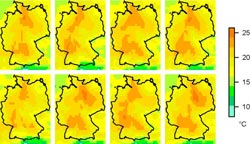The Science of Forecasting

A 24-hour ensemble temperature forecast for Germany with eight different deterministic predictions.<br><br>Image: HITS/Gneiting<br>
“Prediction is very difficult, especially about the future,” the Danish physicist Niels Bohr said – probably; because this quote has been attributed to at least five people. Probability is also linked to predictions, especially for such complex events like the weather and the economy. Tilmann Gneiting deals with the mathematical foundations of such predictions.
The mathematician has begun his work as leader of the newly established research group “Computational Statistics” at the Heidelberg Institute for Theoretical Studies (HITS) and W3 professor at the Institute of Stochastics at the Karlsruhe Institute for Technology (KIT). His research group is located at HITS. The joint appointment reflects the intensive cooperation between the institutions. With Tilmann Gneiting and Alexandros Stamatakis (Bioinformatics), two HITS researchers now are professors at the KIT.
“The new group is an important element of our concept”, says Klaus Tschira, who established the HITS as a non-profit research institute of the Klaus Tschira Foundation in 2010. “After all, the amount of data in science is increasing exponentially, and mathematical methods are essential for making sense of big data.”
Tilmann Gneiting (47) studied mathematics and geoecology at the Universities of Stuttgart and Bayreuth and Boston University. After having received his Ph.D. from the University of Bayreuth in 1997, he held faculty positions in the Department of Statistics at the University of Washington in Seattle (U.S.), where he completed the tenure track from assistant professor to full professor. Gneiting, born in Backnang, returned to Germany in 2009 with the support of the Alfried Krupp von Bohlen und Halbach Foundation, and started work as Professor of Mathematical Statistics at the Institute for Applied Mathematics at the University of Heidelberg. In 2011, he was awarded an ERC Advanced Grant of 1.7 million Euro in support of his research.
Tilmann Gneiting’s work focuses on two main areas: the theory and practice of forecasts, and spatial statistics. “There has been a paradigm shift from deterministic to probabilistic forecasting”, Tilmann Gneiting says. “In weather forecasts, we no longer simply claim that it will rain tomorrow. Instead, we state how probable it is that it will rain tomorrow. While probabilistic forecasts might be inconvenient for decision makers, as they take account of intrinsic uncertainties, they get closer to the truth and allow for better decisions.”
Scientists now frequently use so-called ensemble forecasts that comprise a collection of deterministic predictions, by running a predictive model multiple times, using modified initial values and process parameters. On the basis of the ensemble forecast, probability statements for future events can be generated.
Several years ago, Tilmann Gneiting and his U.S. colleagues created a real-time probabilistic weather forecast website for the state of Washington. These real-time predictions are available online at http://www.probcast.com. For this, Gneiting combined ensemble forecasts with newly developed statistical methods, feeding weather events of the respective past month into the computer.
“Many national weather services now use this method”, Tilmann Gneiting says. He cooperates with numerous meteorological and hydrological organizations, such as the German Weather Service, the German Federal Institute for Hydrology, and the European Center for Medium-Range Weather Forecasts.
Gneiting also does research on economic forecasts. He currently works on papers concerning forecasts of economic quantities such as inflation rates or gross domestic product.
In his second research area, spatial statistics, Tilmann Gneiting and his research team create artificial worlds on the computer, which can be used to simulate natural features, such as wind fields or scenery. Using this “virtual material”, existing data can be made visible, be interpreted and augmented. This thread of basic research has numerous potential applications, For example, it might support as the search for ideal locations for renewable energy resources.
Press Contact:
Dr. Peter Saueressig
Public Relations
Heidelberg Institute for Theoretical Studies (HITS)
Phone: +49-6221-533245
Peter.saueressig@h-its.org
www.h-its.org
Twitter: @HITStudies
Margarete Lehné, M.A.
Press Officer
Karlsruhe Institute for Technology (KIT)
Phone: +49 721 608-48121
Fax: +49 721 608-43658
margarete.lehne@kit.edu
www.kit.edu
Scientific Contact:
Prof. Dr. Tilmann Gneiting
Group leader Computational Statistics (CST)
Heidelberg Institute for Theoretical Studies (HITS)
Phone: +49-6221-533287
tilmann.gneiting@h-its.org
Media Contact
All latest news from the category: Earth Sciences
Earth Sciences (also referred to as Geosciences), which deals with basic issues surrounding our planet, plays a vital role in the area of energy and raw materials supply.
Earth Sciences comprises subjects such as geology, geography, geological informatics, paleontology, mineralogy, petrography, crystallography, geophysics, geodesy, glaciology, cartography, photogrammetry, meteorology and seismology, early-warning systems, earthquake research and polar research.
Newest articles

Properties of new materials for microchips
… can now be measured well. Reseachers of Delft University of Technology demonstrated measuring performance properties of ultrathin silicon membranes. Making ever smaller and more powerful chips requires new ultrathin…

Floating solar’s potential
… to support sustainable development by addressing climate, water, and energy goals holistically. A new study published this week in Nature Energy raises the potential for floating solar photovoltaics (FPV)…

Skyrmions move at record speeds
… a step towards the computing of the future. An international research team led by scientists from the CNRS1 has discovered that the magnetic nanobubbles2 known as skyrmions can be…




















